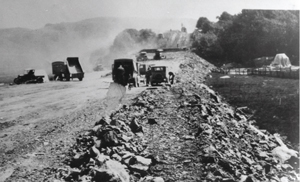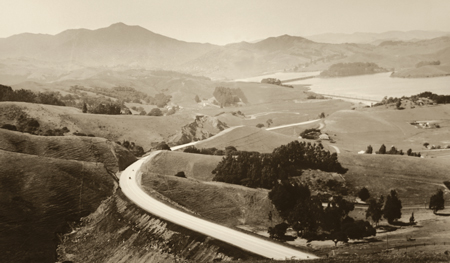What’s a history lesson without an exam? This is an open book test—the answers are in the story that follows.
1. In 1909, what was the original “State Highway” route through Marin County?
2. Were billboards ever allowed along U.S. Highway 101 in Marin? Why are there none now?
3. The Golden Gate Bridge and the original Waldo Tunnel were completed in 1937; both significantly impacted Highway 101. Who was Waldo?
“Someday, someone should write a book about Highway 101 in Marin,” says local historian Barry Spitz. “No aspect of the county’s infrastructure plays a bigger role in our daily lives.” According to Spitz’s Marin, a History, the original “State Highway,” as it was designated in Marin in 1909, was a collection of Miwok trails and county roads that started at the ferry terminal in Sausalito and traveled a westerly course around Richardson Bay.
After passing just-completed Tamalpais Union High School, it bypassed downtown Mill Valley and followed today’s Camino Alto over the hill into Corte Madera. From there, it went through Larkspur, Ross, and San Anselmo, before turning east onto what’s now San Rafael’s Miracle Mile. The original “State Highway” then traveled down Fourth Street and turned north at today’s Lincoln Avenue before going through what would become Novato (today’s Redwood Highway), into the California redwoods and eventually on to Oregon.
That circuitous route through Marin was four miles longer than what the current six- and eight-lane 101 travels between Sausalito and San Rafael. Thus, in 1925 the U.S. government authorized construction of U.S. Highway 101, the nation’s westernmost federally owned highway. By 1929, work on a direct passage through Marin had begun. “They constructed the Redwood Highway right across the marshland,” reads A History of Corte Madera, edited by Jana Haehl. “After it was finished, tidal waters sometimes rose on both sides of the highway, giving motorists a sense of trepidation as they drove atop the dike that formed the roadbed.” Today, that roadway is eight-lanes wide, and Town Center and the Village at Corte Madera shopping centers occupy those marshlands.
 According to Caltrans historian Alicia Whitten, the conversion to a direct route through Marin culminated with the November 1931 completion of the Redwood Bridge, a quarter-mile span over Richardson Bay. “It was built of redwood timbers, supposedly to last hundreds of years,” Whitten adds. “But just 25 years later, in 1956, it was replaced with a much wider steel and concrete structure.”
According to Caltrans historian Alicia Whitten, the conversion to a direct route through Marin culminated with the November 1931 completion of the Redwood Bridge, a quarter-mile span over Richardson Bay. “It was built of redwood timbers, supposedly to last hundreds of years,” Whitten adds. “But just 25 years later, in 1956, it was replaced with a much wider steel and concrete structure.”
In 1935—even before the Golden Gate Bridge opened—Marin County moved to ban billboards along its stretch of Highway 101. “This was sore subject number one for Sepha Evers, a cofounder of today’s Marin Conservation League,” says historian Spitz. Her efforts resulted in passage of County Ordinance 226, which, Spitz says, “required architectural approval of all signs within 500 feet of the highway. Eventually, Marin’s billboards disappeared—and never reappeared.”
Traffic-wise, the most significant impact on Highway 101 in Marin was the May 27, 1937, opening of the Golden Gate Bridge. Before the bridge, the highway handled approximately 1.5 million cars annually. Within 10 years of the bridge’s opening, 7.8 million vehicles crossed it in a year and traveled some part of Highway 101 in Marin.
“Now, 60 years later,” says Mary Currie, public affairs director for the Golden Gate Bridge District, “39.3 million bridge crossings were made in 2008.” This equates to roughly 115,000 cars a day traveling somewhere on Highway 101 in Marin.
The Waldo Tunnel also opened in 1937. The original 1,000-foot bore was four lanes wide, handled two-way traffic and cost $630,346. In the mid-’50s, a second tunnel opened to handle southbound traffic (northbound uses the original tunnel). It cost $1.75 million. As for local color, according to Currie, blissful hippies did not paint the rainbows on the southern portals. “In the ’70s, Alan Hart, a Caltrans engineer, came up with that concept,” she states, “and Caltrans has maintained them ever since.”
The explanation for the name Waldo is less precise. According to Louise Teather’s Place Names of Marin, “During the 1849 Gold Rush, William Waldo heroically delivered food and supplies to snowbound immigrants in the Sierra Nevada.” A few years later, he ran unsuccessfully for governor of California, and, according to several accounts, spent time campaigning in a mining camp named Sailor’s Diggings, which, unfortunately for Waldo, was in Oregon. (In tribute, the village later changed its name to Waldo; it is now a ghost town.) Waldo did leave his mark on Marin, though—Marin City has a Waldo Court, Sausalito has Waldo Point Harbor, and Highway 101 has Waldo Grade and its rainbow-emblazoned tunnel.
The history of Highway 101’s 29 miles in Marin is one of steady expansion. In 1942, the elevated roadbed through San Rafael was completed and 10 years later came the first versions of “cloverleaf” turnouts at Sir Francis Drake Boulevard and North San Pedro Road. Through the 1970s and 1980s, numerous projects transformed 101 into the veritable freeway it is today. Obviously, the evolution has continued. Beginning in 2002, from Greenbrae to Terra Linda, a major project upgraded the interchange with Interstate 580 and widened Highway 101 to create continuous carpool lanes from Highway 37 in Novato to the Richardson Bay Bridge approaching Sausalito. Within weeks, this $132 million project will be completed.
As Marin changes in the future, so will Highway 101. Or should it now be referred to as the 101 Freeway? Whatever it is called, it is—for better or for worse—the county’s major artery, and its evolution will continue to influence how we live.


